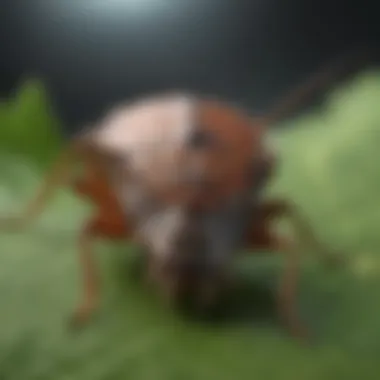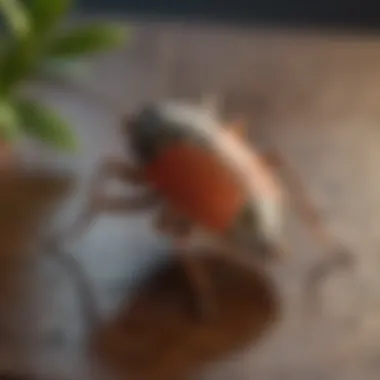Effective Strategies for Stink Bug Control


Intro
Stink bugs present a significant nuisance for many homeowners. Understanding their behavior and biology is essential in managing their presence effectively. This article will focus on preventive pest control strategies to help keep stink bugs at bay. Homeowners can adopt several proactive methods that reduce their chances of sheltering these pests.
Preventive Pest Control Strategies
Effective control begins with preventive measures. Strategies can be divided into various categories, ensuring a comprehensive approach to pest management.
House Exterior Protection
Focusing on the exterior of the home is crucial. Here are some actions to consider:
- Tips for sealing cracks: Inspect the exterior walls. Pay attention to windows and doors. Use caulk to seal gaps and cracks. Proper sealing can prevent stink bugs from entering the home.
- Clearing debris: Maintain a clean yard. Remove piles of leaves, wood, or other debris around the house. Stink bugs often hide in such areas, so keeping them clear minimizes their habitats.
- Preventing pests from entering: Install door sweeps. Ensure that screens on windows and doors fit tightly. This adds another barrier against stink bugs.
Yard Maintenance
Proper yard care is essential in pest management.
- Essential yard care routines: Regularly mow the lawn and trim shrubs. A tidy yard looks less inviting to pests.
- Methods for keeping yard pest-free: Consider planting pest-resistant flowers and plants. Certain herbs like mint and basil can deter pests naturally.
Indoor Cleanliness
Maintaining a clean indoor environment can deter pests effectively.
- Expert cleaning tips and techniques: Regularly vacuum and clean corners of the home. Pay attention to areas where food debris may gather, as these attract pests.
- Maintaining a pest-resistant indoor environment: Store food in sealed containers. Keep surfaces clean and free of spills.
Garbage Disposal
Proper garbage management plays a vital role in pest control.
- Efficient waste disposal methods: Use tightly sealed trash bins. Ensure compost piles are covered to minimize attracting pests.
- Importance of proper garbage disposal: Dispose of trash regularly and clean bins to avoid unpleasant odors which can attract stink bugs and other pests.
Other Pest Prevention Strategies
Adopting innovative methods can further safeguard your home.
- Innovative ways to safeguard your home: Use natural bug repellents, such as citronella, near entry points. Employ traps strategically around the house to catch any stray stink bugs.
Identifying Pest Risk Areas
Recognizing potential areas where stink bugs might thrive is key to preventing infestations.
Moisture Prone Areas Inspection
Stink bugs love damp conditions.
- Identifying damp conditions: Regularly check basements and other low-lying areas. Identify leaks or moisture buildup.
- Tips for preventing infestations: Repair leaks promptly and use dehumidifiers in damp areas to reduce moisture.
Crack and Crevice Inspection Guide
Inspecting your home for potential entry points is essential.
- Importance of inspecting access points: Regular inspections can locate potential entry areas for stink bugs.
- Strategies for sealing cracks and crevices: Use expanding foam or caulk to seal any gaps. Thoroughly check around windows and doors.
Greenery Inspection for Pest Risks
Plants around your home can attract pests.
- Understanding greenery's impact on pests: Some plants can harborage stink bugs. Monitor the types of vegetation you have near your home.
- Guidelines to maintain pest-free yards: Choose native plants that naturally deter pests. Regular pruning can help maintain a healthier landscape.
Additional Pest Risk Areas
Several miscellaneous locations should also be considered in pest prevention.
- Miscellaneous pest risk areas and preventive measures: Inspect attics and crawl spaces regularly. These areas can often be overlooked but may provide harborage for pests.
Always be vigilant about identifying pest risk areas in and around your home. Prevention is more effective than control once an infestation has begun.
Effective Pest Control Methods
In addition to preventive measures, knowing what effective control methods are available is beneficial.
Natural Repellents for Pest Control
Homeowners can use natural solutions.
- Safe and effective natural solutions: Essential oils like peppermint and eucalyptus can deter stink bugs.
- Use of essential oils, herbs, and plants: Plants such as marigolds can act as natural repellents.
Chemical Sprays for Pest Control
Despite natural solutions, chemical options can be necessary.
- Safe usage of professional sprays: Follow manufacturer instructions carefully to minimize risks.
- Eradicating pests with chemical solutions: Use targeted sprays during peak activity periods for best results.
Pest Traps: Effective Pest Control Solutions
Traps can be quite efficient.
- Setting up and using pest traps: Position traps near entry points to effectively capture pests as they enter.
- Capturing and removing pests safely: Check traps regularly to ensure they are empty and maintain cleanliness for effectiveness.
Biological Control Methods for Pest Prevention
Employing natural predators can reduce pest populations.


- Using natural predators for pest management: Introducing beneficial insects could assist in maintaining a balanced ecosystem.
- Environmental-friendly pest control techniques: Favoring biological methods aligns with sustainable practices.
Other Pest Control Methods
Exploring various pest control options is wise.
- Innovative pest control methods beyond traditional options: Consider high-frequency sound devices that deter pests without harming them.
This comprehensive approach serves as a practical guide to effectively manage and control stink bug populations within your living spaces.
Understanding Stink Bugs
Understanding stink bugs is critical for effectively managing their presence in residential areas. This section provides foundational knowledge about their biology, behavior, and common species, which are important when exploring strategies for control. Knowing how stink bugs operate assists homeowners in making informed decisions on repellents and preventive measures. It also helps to recognize the signs of an infestation early, minimizing damage to property and ensuring a better quality of life.
Biology and Behavior
Stink bugs belong to the family Pentatomidae. They are known for their shield-like shape and the distinct odor they emit when threatened. Their bodies are generally flattened, which allows them to hide effectively in crevices and foliage. Their primary food source consists of plant materials, which makes them more prevalent in agricultural settings.
Behaviorally, stink bugs are most active in the warm months. They are attracted to the light and tend to congregate around windows or outdoor lights. These insects are not known to bite humans; however, their presence can be bothersome due to their odor and the potential damage they cause to plants. Stink bugs tend to seek shelter indoors as temperatures drop, making homes especially vulnerable in the fall season.
Common Species
Several species of stink bugs are prevalent in North America, with the brown marmorated stink bug being among the most infamous. This species originated from Asia and has since established itself across various regions. It is easily recognizable due to its brown coloration and distinct markings.
- Brown Marmorated Stink Bug: Known for its ability to invade homes during the cooler months. It is primarily an agricultural pest as it damages a variety of crops.
- Green Stink Bug: This species has a bright green body and is often found in gardens. It feeds on plants, causing significant damage to fruits and vegetables.
- Southern Green Stink Bug: Often found in southern climates, this species also poses a threat to crops and can multiply rapidly.
Recognizing these species is key for homeowners to identify potential threats in their environment and take appropriate action.
Life Cycle and Habits
The life cycle of stink bugs consists of four stages: egg, nymph, juvenile, and adult. The female lays clusters of eggs on the underside of leaves. Once hatched, nymphs resemble miniature adults but lack wings.
- Egg Stage: Eggs are usually laid in clusters, which hatch within one to two weeks.
- Nymph Stage: These young bugs feed voraciously and grow through several molts before becoming adults.
- Adult Stage: Adult stink bugs are responsible for continuing the cycle. They can reproduce multiple times throughout the warm months.
The feeding habits of stink bugs often lead to wilting and potential death in plants. Moreover, their tendency to invade homes adds to the complications they pose.
This understanding lays the groundwork for identifying effective repellents and controlling stink bug populations in households.
Impact of Stink Bugs
The impact of stink bugs extends beyond mere annoyance. These pests can cause significant problems in agricultural settings and residential areas alike. Their presence can lead to severe agricultural damage, affecting crop yields and economic stability for farmers. Furthermore, when they infiltrate homes, stink bugs can disrupt daily life, impacting comfort and cleanliness. In providing effective repellent strategies, it is crucial to understand these impacts thoroughly.
Agricultural Damage
Stink bugs are notorious for their detrimental effects on various crops. They feed on fruits, vegetables, and ornamental plants, weakening the plants and reducing their market value. Common agricultural pests include the brown marmorated stink bug and the green stink bug. These species are able to reproduce quickly, making it challenging to manage infestations. Crop losses can reach alarming rates, necessitating stringent measures from farmers to protect their yields.
Key considerations regarding agricultural impact:
- Crop types: Certain crops, such as apples, peaches, and soybeans, are particularly vulnerable to stink bug infestations.
- Seasonal peaks: Infestation levels can vary by season, with significant surges occurring during warmer months.
- Control costs: Farmers may incur high costs for pest control, impacting overall profitability.
Taking action against these pests is crucial. Comprehensive understanding of their feeding habits and preferred environments can aid in developing targeted control strategies.
Home Infestation Issues
Stink bugs are not only agricultural pests but also a common nuisance in residential areas. When they invade homes, they can create ongoing problems. Their distinctive odor can pervade living spaces, making everyday activities unpleasant. Moreover, they tend to congregate in large numbers, particularly in the fall, as they seek shelter from the cold.
Considerations for home infestations include:
- Entry points: Stink bugs can enter through small gaps around windows, doors, and even cracks in walls. Regular home maintenance practices can mitigate entry risk.
- Behavioral patterns: Understanding their habits, such as their tendency to hide in quiet, dark areas, can assist in effective pest control.
- Environmental impact: Homeowners may search for eco-friendly repellent methods. Knowledge of both chemical and natural solutions can guide this pursuit.
Preventive strategies and effective repellent techniques can greatly reduce the likelihood of infestations, thus improving comfort in the home environment.
Identifying Effective Repellents
Identifying effective repellents is crucial in the quest to manage stink bug populations. Understanding how to repel these pests not only protects your home but also helps maintain the integrity of crops and gardens. A comprehensive approach to repellents involves evaluating the merits of various products and their application techniques. With both chemical and natural options available, homeowners need to consider efficacy, safety, and environmental impact. This balanced consideration ensures that the selected strategies do not merely chase away stink bugs but do so without introducing other issues.
Chemical Repellents
Chemical repellents are a popular choice for many homeowners and pest control professionals. These products, often available in various formulations, have been designed specifically to target and repel stink bugs effectively. Common chemical repellents include pyrethroids and neonicotinoids.
- Pyrethroids are widely used due to their effectiveness against a broad range of pests, including stink bugs. They work by disrupting the nervous system of insects, which leads to immobilization and death. Common pyrethroid products include permethrin and lambda-cyhalothrin. Homeowners often find these substances in aerosol sprays and concentrated liquids, making application straightforward.
- Neonicotinoids, on the other hand, act on the insect's central nervous system and are effective even in low doses. While they have proven efficacy, concerns about their impact on beneficial insects, like bees, have emerged. Products like imidacloprid and thiamethoxam are examples, but caution is advisable when using them.
When utilizing chemical repellents, homeowners must consider a few factors:
- Application Timing: Timing can influence their effectiveness. Applying during periods when stink bugs are most active ensures maximum contact.
- Location: Concentrate on areas where stink bugs are frequently spotted, such as entry points, plants, and potential nesting sites.
- Safety Precautions: Always read labels and follow safety guidelines to minimize exposure to family and pets.
Natural Repellents
For those seeking alternatives to chemical methods, natural repellents can be an effective solution. Homeowners may prefer these options for their lower environmental impact and perceived safety. Some common natural repellents include essential oils and diatomaceous earth.
- Essential Oils: Many essential oils possess insect-repelling properties. Oils like peppermint, clove, and cedarwood are particularly noted for their effectiveness against stink bugs. They can be used in diffusers or mixed with water for spraying. The scent masks the natural pheromones that stink bugs use for navigation.
- Diatomaceous Earth: This fine powder, made from the fossilized remains of tiny aquatic organisms, acts mechanically rather than chemically. Diatomaceous earth damages the exoskeletons of insects upon contact, leading to dehydration. It is safe for humans and pets but should be applied carefully to ensure effectiveness.
Comparing Chemical Repellents
When it comes to managing stink bugs, the effectiveness of chemical repellents cannot be overlooked. These products offer targeted solutions that can yield immediate results. Understanding the different types of chemical repellents is essential for homeowners seeking reliable options. Each type offers unique benefits, yet they also entail specific considerations regarding safety and environmental impact.
Chemical repellents primarily fall into two categories: pyrethroids and neonicotinoids. By comparing these two, one can make informed decisions based on effectiveness, application methods, and potential effects on non-target species.
The advantages of employing chemical repellents include rapid action against stink bug infestations and long-lasting effects, which can help minimize future occurrences. Moreover, these products can be applied in a variety of settings, allowing for both indoor and outdoor use.
Before choosing a chemical repellent, homeowners should consider factors such as:
- Efficacy against stink bugs: Some repellents are specifically designed to target these pests more effectively than others.
- Safety for humans and pets: Many chemical solutions pose risks; hence, reading labels carefully is crucial.
- Environmental impact: Many users are increasingly conscious of the ecological consequences associated with chemical use.
Understanding these elements can significantly influence the selection of chemical repellents in any stink bug control strategy.


Pyrethroids
Pyrethroids are synthetic chemical compounds modeled after pyrethrins, which are natural insecticides derived from chrysanthemum flowers. They function by attacking the nervous system of insects, causing paralysis and death. Pyrethroids are commonly used in many household insect repellents due to their effectiveness against a wide range of pests, including stink bugs.
Some benefits associated with pyrethroids:
- Rapid knockdown effect: Pyrethroids can quickly incapacitate stink bugs upon contact.
- Residual activity: This chemical remains effective for days or weeks after application, depending on environmental conditions.
- Low toxicity to mammals: When used as directed, they pose minimal risk to humans and pets.
However, there are considerations to keep in mind:
- Potential for resistance: Over-reliance may lead to reduced effectiveness over time, as bugs can develop resistance.
- Effects on beneficial insects: Pyrethroids do not selectively target stink bugs; they can harm beneficial pollinators if used indiscriminately.
Neonicotinoids
Neonicotinoids are another class of chemical repellents. They mimic nicotine and interfere with the nervous system of insects, leading to paralysis and eventual death. These chemicals are often used in agricultural settings but can also be effective in household applications.
Advantages of neonicotinoids include:
- Targeted action: These chemicals are more selective, primarily affecting insects rather than mammals.
- Systemic application: Some neonicotinoids can be applied to soil or vegetation, allowing plants to absorb the chemical and protect against stink bugs that feed on them.
Nevertheless, certain drawbacks must be acknowledged:
- Environmental concerns: Neonicotinoids have been implicated in declines of pollinator populations, raising alarms among environmentalists and regulators.
- Regulatory restrictions: In some areas, the use of neonicotinoids is restricted due to their ecological impact.
The choice between pyrethroids and neonicotinoids can significantly affect pest management strategies, emphasizing the need for responsible use.
Spotlight on Natural Solutions
Natural solutions for controlling stink bugs offer several advantages, making them a crucial part of any effective pest management strategy. Unlike synthetic chemical repellents, natural methods typically pose less risk to human health and the environment. The shift toward these alternatives is driven by an increasing awareness of ecological balance and a desire to minimize chemical use in and around homes.
Among the notable benefits are their accessibility and versatility. Natural repellents can often be sourced from everyday household items or ingredients, which means homeowners can implement these strategies without incurring significant costs. Moreover, these methods can be integrated into a broader strategy involving cleanliness and maintenance, thus reinforcing their effectiveness.
However, while employing natural solutions, homeowners should consider the specific characteristics of their environment and potential allergies to certain substances. This careful evaluation ensures that the adopted measures yield the desired results without unintended consequences.
Essential Oils
Essential oils have garnered attention for their ability to repel stink bugs effectively. Oils such as peppermint, lavender, and eucalyptus are particularly noted for their strong aromas that insects generally avoid. Beyond their repellent properties, these oils can impart a pleasant scent to living spaces.
Homeowners might choose to create a simple spray by diluting a few drops of essential oil in water within a spray bottle. This blend acts as a deterrent when applied to windowsills and door frames, areas where stink bugs frequently enter. Regular reapplication, especially after rain, is key to maintaining their efficacy.
"Natural repellents, like essential oils, not only deter pests but can also enhance the ambiance of your home."
Diatomaceous Earth
Diatomaceous earth is another natural solution that serves well against stink bugs. This powdery substance consists of tiny fossilized aquatic organisms called diatoms. Its unique composition allows it to damage the exoskeleton of insects, leading to dehydration and death.
To use diatomaceous earth, one should sprinkle it in areas where stink bugs are known to congregate. This includes around the foundation of the home, near entry points, and in garden beds. It is important to apply it in dry conditions, as moisture reduces its effectiveness. Regular application may be necessary, particularly after rainfall.
Employing diatomaceous earth in conjunction with good hygiene practices can significantly reduce stink bug populations. Cleaning clutter, ensuring tight seals on windows and doors, and removing potential breeding grounds outside can amplify its effectiveness.
Optimal Application Techniques
Effective stink bug control requires more than just a good repellent; it is crucial to apply these solutions in a manner that maximizes their efficacy. Optimal application techniques play a significant role in how well these methods work to keep these pests at bay. Appropriate techniques can enhance the coverage of repellents and offer strategic advantages over infestations, ensuring better results for homeowners.
Utilizing the right methods not only increases the effectiveness of both chemical and natural repellents but also minimizes the possibility of stink bugs returning. Factors like application timing, environmental conditions, and specific target areas are essential to consider to ensure that the repellents will have the desired impact. Poor application can lead to suboptimal results, wasting time and money.
Homeowners should also select the right tools for application, whether it is a sprayer, brush, or other devices. Different methods may require different approaches to achieve the best outcomes in repelling stink bugs. Understanding these principles can keep stink bug populations in check before they become a major nuisance.
Spraying Methods
Spraying is one of the most common methods for applying chemical and natural repellents. This technique allows for a direct application to areas where stink bugs are likely to congregate, such as windows, door frames, and other entry points.
- Frequency and Timing: It is essential to spray during the peak activity times of stink bugs, typically early morning or late afternoon. Regular applications can help build a protective barrier over time.
- Choice of Sprayer: Homeowners can opt for handheld spray bottles or backpack sprayers. Each option offers specific benefits depending on the area that needs treatment. For larger areas, a backpack sprayer may facilitate a more thorough application.
- Safety Considerations: It is critical to follow safety guidelines when applying chemical repellents. Proper gear including gloves and masks should be used to prevent exposure to harmful substances.
Spraying can become an effective method when done properly, ensuring an area is treated with the right amount of product, preventing excessive usage that could harm the environment.
Traps and Barriers
Traps and barriers provide another approach to controlling stink bugs, promoting a non-chemical method. This strategy greatly reduces the chances of a severe infestation.
- Physical Barriers: Simple physical barriers, such as caulking cracks and installing screens on windows and doors, can prevent stink bugs from entering the home. This is a proactive step that significantly reduces potential encounters with these pests.
- Homemade Traps: Homeowners can create traps using soapy water placed in bowls, effectively attracting and capturing stink bugs. This method is not only straightforward but also environmentally friendly.
- Commercial Traps: Several traps are available on the market specifically designed to target stink bugs. These traps often use pheromones to attract pests and trap them effectively. Positioning these traps near known entry points increases their likelihood of catching stink bugs.
By combining spraying methods with effective traps and barriers, homeowners can enhance their stink bug control strategies significantly. This dual approach addresses the issue from multiple angles, preventing infestations and reducing the insects' presence in homes.
Remember: Consistency and strategic timing in applying these techniques enhance their overall effectiveness.
Evaluating Effectiveness
Evaluating effectiveness is a critical process in understanding how well various repellents can manage stink bug populations. This section focuses on the importance of assessing the performance of different products. Knowing what works helps homeowners make informed decisions. An effective repellent should have measurable results, so it is essential to consider various factors such as duration of efficacy, ease of application, and overall safety.
- Duration of Efficacy: The lifespan of a repellent influences its practicality. Homeowners need to know how often they must reapply a product to maintain effectiveness. Some chemical repellents may last longer than natural alternatives, making them more appealing for those who prefer low-maintenance solutions.
- Ease of Application: A product that is simple to apply can save time and effort. Understanding different application techniques is vital. Some repellents need spraying, while others might be applied as granules or powders.
- Overall Safety: The safety of repellents is fundamental, especially for households with children and pets. Homeowners should always consider whether a repellent poses additional risks to their environment.
"Finding the right balance between effectiveness and safety makes all the difference when choosing stink bug repellents."
Understanding these elements provides a wider perspective on the performance of different repellents. This careful evaluation can ultimately enhance the management of stink bug infestations and minimize their impact on homes and gardens.
Field Studies and Research
Field studies and research play a fundamental role in determining the effectiveness of stink bug repellents. Scientific research contributes to the validation of various products. These studies often take place in different environments to observe how repellents perform under varied conditions. They delve into specifics like:
- Comparative Analysis: Researchers typically compare the efficacy of chemical and natural repellents. By documenting outcomes, they help establish which products offer the best protection.
- Longitudinal Studies: Extended research periods can provide insights into long-term viability and seasonal effectiveness. They analyze how environmental factors impact repellent performance.
- Field Trials: Conducting trials ensures that results reflect real-world scenarios. These can include controlled environments that simulate typical stink bug infestation settings.
Results from this field research are instrumental for homeowners. They can provide clarity on which products yield satisfying results based on scientific analysis, not just marketing claims.
User Experiences


User experiences serve as valuable qualitative data about the effectiveness of repellents. Real-life feedback can highlight various aspects that scientific studies may overlook. Homeowners often share insights about their interactions with specific products, including:
- Practicality of Use: Users testify to how easy or difficult a repellent is to apply. Their stories can guide others in selecting products that fit their lifestyles.
- Efficacy: Many homeowners can recount their success or failure with different repellents. Their firsthand accounts reveal what worked or did not inspire confidence.
- Safety Concerns: Experiences shared online, through platforms like Reddit and forums, often address safety issues. Potential users can gain knowledge about any side effects reported from particular products.
This information helps create an informed community. By considering both scientific evidence and user commentary, homeowners can feel empowered to make choices regarding stink bug control.
Preventive Measures
Preventive measures are crucial in controlling stink bugs. They not only minimize the chances of an infestation but also address potential issues before they escalate. This proactive approach often saves time, effort, and costs in dealing with these pests once they have settled in.
Establishing a solid prevention plan involves several specific elements. One significant aspect is home maintenance practices. Regular upkeep of the property can effectively deter stink bugs from entering. This ranges from sealing cracks and gaps to proper landscaping. Paying attention to both the interior and exterior can create an environment that is less inviting to these pests.
Another important consideration is seasonal strategies. Understanding the habits of stink bugs, especially their seasonal patterns, can inform better preventive tactics. As temperatures change, stink bugs look for shelter, often moving indoors. By implementing strategies tailored to each season, homeowners can stay one step ahead.
"An ounce of prevention is worth a pound of cure." This adage holds true when it comes to managing stink bugs.
Home Maintenance Practices
Home maintenance practices play a vital role in keeping stink bugs at bay. Firstly, it is important to inspect all possible entry points around the home. Look for gaps around windows, doors, and vents. Sealing these openings with caulk or weather stripping can drastically reduce the chances of their entry. Also, ensure that screens on windows and doors are intact and without holes.
Cleaning the home regularly is another effective prevention measure. Stink bugs are attracted to food sources and shelter, so keeping the environment clear of clutter and food remnants is essential. Vacuuming frequently can help remove any wandering bugs. Dispose of vacuum bags promptly to avoid re-infestation.
Additionally, consider the outside area. Trim back any vegetation close to the house. Stink bugs may use plants as a bridge to enter the home. Keeping foundation plants at a distance and clearing debris can help in deterring them.
Seasonal Strategies
Implementing seasonal strategies is crucial for effective stink bug control. During early spring, stink bugs begin emerging from their overwintering spots. This is the time to be especially vigilant. Check around the home for any signs of them. Apply repellents or introduce barriers if necessary.
As summer arrives, behavior monitoring is important. Maintain an environment that is less appealing by managing the landscape. Remove any standing water as it attracts various pests, including stink bugs. Additionally, consider using natural repellents, like essential oils, to create a less inviting aura for these pests.
In the fall, stink bugs seek indoor shelter as temperatures drop. Inspect the house thoroughly during this time. Make sure all entry points are sealed, and check for any other weaknesses in defenses. Introducing traps around entrances during this season can also catch any that try to enter.
Overall, by combining home maintenance with seasonal strategies, homeowners can significantly reduce the likelihood of stink bugs invading their living spaces.
Regulatory Considerations
The regulatory landscape surrounding pest control is increasingly complex. It is essential to understand these regulations as they impact the effectiveness and safety of the products used in controlling stink bugs. One key aspect is ensuring that any repellents utilized comply with local, regional, and federal laws. This compliance guarantees that the methods selected for stink bug control do not pose unnecessary risks to human health or the environment.
The Environmental Protection Agency (EPA) is a critical entity in this context. They oversee the registration of pesticides and ensure that they meet specific safety standards. Homeowners should check if the products they contemplate using are EPA-approved. This information ensures that chemical repellents have undergone rigorous testing for their efficacy and safety.
Moreover, understanding local regulations is important because they can vary significantly. Some areas may restrict certain chemicals or suggest specific application techniques to mitigate runoff or potential harm to wildlife. By adhering to these guidelines, homeowners can not only protect their homes from stink bugs but also contribute to a broader environmental responsibility.
"Compliance with regulatory standards is not just about legality; it's about safeguarding health and preserving ecosystems."
In summary, familiarizing oneself with regulatory considerations is a fundamental step in selecting the best repellents for stink bugs. By choosing compliant products, homeowners ensure effective pest control while maintaining ecological balance.
Safety Guidelines
When selecting pest control methods, safety guidelines are paramount. These guidelines assist homeowners in making informed choices that prioritize health and security. First, it is essential to read product labels thoroughly. Labels provide crucial information regarding safe usage, proper dosage, and necessary protective gear. For instance, many chemical repellents advise wearing gloves and masks during application to minimize skin contact and inhalation risks.
Homeowners should also consider the immediate environment. If young children or pets are present, selecting less hazardous options is advisable. Opting for repellents that are deemed safe for use around families can significantly decrease health risks. Additionally, when applying chemical repellents, it's essential to ensure proper ventilation in the area. This step reduces airborne exposure and contributes to the overall safety of the home environment.
Furthermore, integrating integrated pest management (IPM) practices can be beneficial. IPM encourages a balanced approach that combines multiple strategies, such as physical barriers, biological controls, and appropriate chemical use, thereby reducing the reliance on any single method. This approach results in lower risks associated with chemical exposure.
Environmentally Responsible Choices
Making environmentally responsible choices when selecting stink bug repellents is increasingly critical for homeowners. With growing awareness about sustainability, many individuals are seeking approaches that not only protect their homes but also have minimal adverse effects on ecosystems. Utilizing natural and organic repellents can be an excellent way to achieve this. Many natural substances, such as essential oils from mint and lavender, repel stink bugs without harming beneficial insects.
Moreover, prioritizing products that are biodegradable and have low toxicity levels can help reduce environmental impact. These products typically break down more quickly in the environment and do not pose long-term hazards.
When considering the packaging of repellents, it is wise to select brands that prioritize sustainability. Many companies are moving towards eco-friendly packaging that minimizes plastic waste. Choosing products from these companies supports responsible manufacturing practices and contributes to overall environmental health.
It is also worthwhile to research local companies that produce organic pest control products. Supporting local businesses not only bolsters the economy but also often leads to the use of ingredients that have a lower impact on the surrounding ecosystem.
Investing in environmentally responsible pest control is not merely a trend; it reflects a deeper commitment to sustainability and long-term health for both people and the planet.
Future Trends in Stink Bug Control
The challenge of controlling stink bugs continues to evolve, necessitating the exploration of innovative strategies and technologies. Understanding future trends in stink bug control is vital for homeowners seeking effective solutions. As pest behavior and environmental factors merge with advancements in science, new methodologies can greatly influence the effectiveness of repellent strategies. Adopting these emerging trends will allow for a more proactive approach in managing infestations, ultimately leading to sustainable living environments.
Emerging Technologies
Recent developments in pest control highlight a shift towards precision and efficiency through technology. Smart traps embedded with sensors can detect stink bugs and alert homeowners via mobile applications. This modern approach not only minimizes the need for chemical interventions, but also fosters a tailor-made response suited to specific situations.
Furthermore, drones are being tested to monitor agricultural fields for stink bugs, providing real-time data for early detection and control measures. This data-driven strategy helps in applying treatments only where necessary, reducing the overall pesticide usage, and helping to protect beneficial insects.
Some innovations include the use of UV light traps, which capitalize on the attraction stink bugs have towards specific wavelengths. These traps work without chemicals, appealing on multiple fronts as they are eco-friendly.
Research in Biological Control
Biological control is an area garnering much interest among researchers. This method involves leveraging natural predators to manage stink bug populations. Certain wasps, for example, are known to parasitize stink bugs, offering a promising solution to curb their numbers. Research is ongoing to understand the specific ecological conditions under which these predators thrive and function effectively.
Moreover, scientists are examining the application of specific bacteria and fungi as biological agents against stink bugs. This research aims to develop targeted biopesticides that can disrupt the life cycle of stink bugs without harming other insects or the environment. This aligns with the increasing call for environmentally responsible pest management solutions.
Finale
In the quest to manage stink bugs effectively, the conclusion of this article underscores significant insights regarding repellent strategies, preventive measures, and the long-term implications for homeowners. Recognizing the intricate behavior of stink bugs is crucial for developing a suitable control plan. A comprehensive approach combines chemical and natural repellents, ensuring homeowners have various tools at their disposal.
Moreover, understanding the lifecycle and habitat preferences of these pests can lead to more effective preventative techniques. Such strategies not only provide immediate relief from infestation but also foster a sustainable environment by minimizing chemical use over time.
Effective stink bug management relies not just on the types of repellents used, but also on a commitment to maintenance and vigilance.
Summary of Key Points
- Identifying Stink Bugs: Know their appearance and behavior.
- Impact Assessment: Recognize the potential damage to homes and crops.
- Types of Repellents: Differentiate between chemical and natural options.
- Application Techniques: Employ best practices when applying repellents.
- Preventive Measures: Maintain home conditions to deter entry.
Recommendations for Homeowners
- Regular Inspection: Check areas like attics and basements for signs of stink bugs.
- Utilize Multiple Repellents: Experiment with various repellents to see which works best in your environment.
- Seal Entry Points: Ensure that windows, doors, and other openings are properly sealed to reduce chances of infestation.
- Clean Surroundings: Remove debris and clutter outside homes which may attract stink bugs.
- Educate Family Members: Share information about stink bugs to increase awareness and proactive measures.
By adhering to these guidelines, homeowners can significantly minimize the chances of stink bug infestation and maintain a more comfortable living environment.



